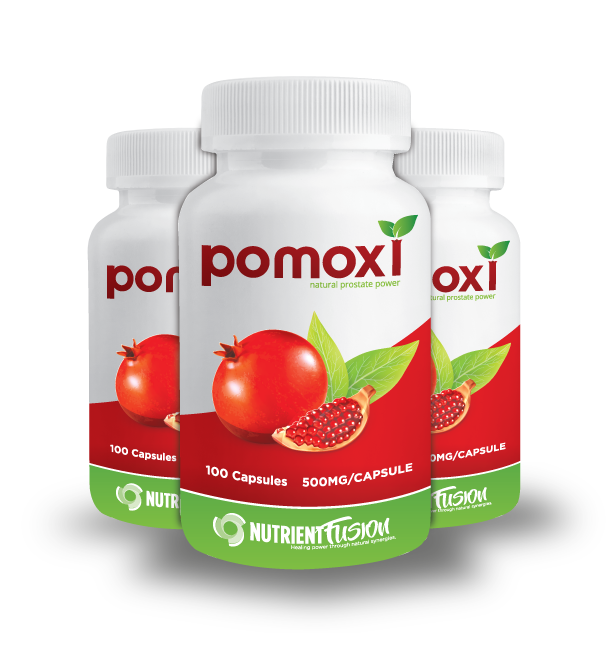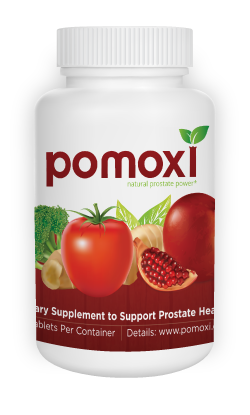Quercitin
A flavonoid with many nutritional and health benefits found in a variety of fruits, vegetables, nuts, herbs, grains, and other foods.

Subscribe and Save 15%
BUY NOW
The Science of Quercitin
Quercetin is the most common flavonoid in the human diet and it is readily recognized by the human body which allows Quercetin into the bloodstream at 10 to 20 times higher levels than other flavonoids. (1, 2)
This is important because Quercetin has prostate-specific health benefits. Quercetin lowers PSA (Prostate Specific Antigen) in cultures of prostate cells, in animal studies and in human studies. PSA is believed to be a general marker of prostate inflammatory status. (3, 4, 5)
Quercetin and other common flavonoids have a remarkably similar structure to testosterone. Quercetin lowers testosterone levels in men and may be one of the reasons that Quercetin also lowers PSA. (5, 6)
Pomoxi contains Quercetin because it is widely available in the human body and in the prostate gland, where it blocks androgens and lowers PSA to support better prostate health.
This naturally-occurring plant compound also has formidable antioxidant qualities, making it a nutritious way to keep your prostate healthy.
However, studies are beginning to show that this flavone may be capable of so much more. Evidence has pointed to the following effects:
First and foremost, as an antioxidant, quercetin prevents free radical damage and mitigates inflammation in the body. These are just small factors, but they can lead to much bigger health concerns.
Studies show that in regular, normal consumption in a regular diet, quercetin has these antioxidant effects, but in higher amounts and doses, the flavonoid demonstrates much more direct activity.
For example: as a phytoestrogen, quercetin can play a role in suppressing androgen activity (specifically testosterone), which in turn stifles the cellular pathways that impact overall health.
Quercetin’s ability to work hand-in-hand with the body’s hormones and receptors makes it a very hopeful natural prostate supporter.
What is Quercitin?
Quercetin is one in a class of compounds called flavonoids. These are plant pigments that have certain nutritional and health benefits, and can be found in a wide variety of fruits, vegetables, nuts, herbs, grains, and other foods.
Along with many other compounds, quercetin is a phytonutrient under rigorous study for its promising health properties. These studies point to possible but very remarkable effects, as anti-inflammatory effects and blood sugar metabolism.
Quercetin is also one in a long lineup of plant compounds that has promise for supporting prostate health. As a potent antioxidant, its influence on free radical damage is more than noteworthy, as it can help maintain normal inflammation.
Taking a supplement that contains quercetin, as well as incorporating quercetin-rich foods into your diet, can bring a boost to one’s prostate supporting regime.
What Foods Contain Quercetin?
While it is not a required nutrient in the human diet (like vitamins and minerals), it may surprise you that quercetin occurs in quite a few common, easily accessible foods.
Foods that contain quercetin:
- Apples (Red Delicious)
- Berries
- Capers
- Carob
- Kale
- Prickly Pear (Nopal)
- Red kidney beans
- Red onions
- Red wine
- Sweet potatoes
- Tea (black or green)
- Watercress
While some of the highest dietary sources of naturally-occurring quercetin (such as capers) are either hard to come by or difficult to eat in large amounts, it should be noted that quercetin tends to be found in greater abundance in foods than most other antioxidant flavonoids.
Food and Supplement Intake
Early studies into quercetin’s possible role in prostate health have been quite hopeful.
Still, the observable effects seen in quercetin are only from studies with extract models. Applying this to humans and animals may be quite different, mostly due to its availability to be used in your body; but also due to how digestion and metabolism affects the compound’s nature after consumption.
The body's ability to use quercetin is quite variable and unpredictable: ranging from 0% all the way up to 50% in some instances. Additionally, the antioxidant is eliminated from the body quite rapidly – within 26 hours.
Lastly, quercetin undergoes intense metabolism that changes its nature and effect during the digestive process, which can take away from its potential.
For this reason, both food intake and supplement sources together are needed to get high amounts of quercetin into the diet, and for the antioxidant to have an effect that is similar to what has been seen in scientific research.
Using Quercetin
Taking a quercetin supplement is considered quite safe, with very few side effects if the correct dosage is upheld.
Talk to your doctor about taking Pomoxi, a supplement that contains quercetin. In addition to this all-natural, plant-sourced flavonoid, Pomoxi contains other non-toxic, well-researched compounds that have prostate health potential – such as beta-sitosterols, sulforaphanes, apigenin, and more.
References
1. Gugler, R., Leschik, M, Dengler, H. J. Disposition of quercetin in man after single oral and intravenous doses. Eur. J. Clin. Pharmacol., 9: 229-234, 1975.
2.Higher plasma quercetin levels following oral administration of an onion skin extract compared with pure quercetin dihydrate in humans. Burak C, Brüll V, Langguth P, Zimmermann BF, Stoffel-Wagner B, Sausen U, Stehle P, Wolffram S, Egert S. Eur J Nutr. 2017 Feb;56(1):343-353.
3. Avancès C, Georget V, Térouanne B, Orio F. et al. (2001) Human prostatic cell line PNT1A, a useful tool for studying androgen receptor transcriptional activity and its differential subnuclear localization in the presence of androgens and antiandrogens. Mol Cell Endocrinol 184:13–24.
4. el-Shirbiny, AM.1994;31:99-133.Prostatic specific antigen. Adv Clin Chem. 1994: 31: 99-133.
5. Yuan H, Young C, Tian Y, et al. Suppression of the androgen receptor function by quercetin through protein–protein interactions of Sp1, c-Jun, and the androgen receptor in human prostate cells. Mol Cell Biochem. 2010;339(1):253–262.
6. Hiipakka RA, Zhang HZ, Dai W, et al. Structure-activity relationships for inhibition of human 5alpha-reductases by polyphenols. Biochem Pharmacol. 2002;63(6):1165–1176.


